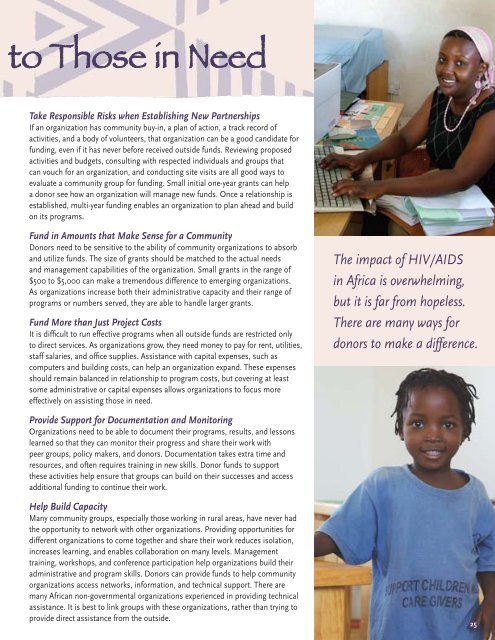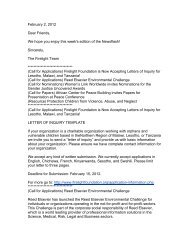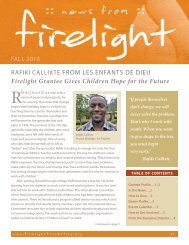From Faith to Action - Faith to Action Initiative
From Faith to Action - Faith to Action Initiative
From Faith to Action - Faith to Action Initiative
- No tags were found...
You also want an ePaper? Increase the reach of your titles
YUMPU automatically turns print PDFs into web optimized ePapers that Google loves.
Take Responsible Risks when Establishing New PartnershipsIf an organization has community buy-in, a plan of action, a track record ofactivities, and a body of volunteers, that organization can be a good candidate forfunding, even if it has never before received outside funds. Reviewing proposedactivities and budgets, consulting with respected individuals and groups thatcan vouch for an organization, and conducting site visits are all good ways <strong>to</strong>evaluate a community group for funding. Small initial one-year grants can helpa donor see how an organization will manage new funds. Once a relationship isestablished, multi-year funding enables an organization <strong>to</strong> plan ahead and buildon its programs.Fund in Amounts that Make Sense for a CommunityDonors need <strong>to</strong> be sensitive <strong>to</strong> the ability of community organizations <strong>to</strong> absorband utilize funds. The size of grants should be matched <strong>to</strong> the actual needsand management capabilities of the organization. Small grants in the range of$500 <strong>to</strong> $5,000 can make a tremendous difference <strong>to</strong> emerging organizations.As organizations increase both their administrative capacity and their range ofprograms or numbers served, they are able <strong>to</strong> handle larger grants.Fund More than Just Project CostsIt is diffi cult <strong>to</strong> run effective programs when all outside funds are restricted only<strong>to</strong> direct services. As organizations grow, they need money <strong>to</strong> pay for rent, utilities,staff salaries, and offi ce supplies. Assistance with capital expenses, such ascomputers and building costs, can help an organization expand. These expensesshould remain balanced in relationship <strong>to</strong> program costs, but covering at leastsome administrative or capital expenses allows organizations <strong>to</strong> focus moreeffectively on assisting those in need.The impact of HIV/AIDSin Africa is overwhelming,but it is far from hopeless.There are many ways fordonors <strong>to</strong> make a difference.Provide Support for Documentation and Moni<strong>to</strong>ringOrganizations need <strong>to</strong> be able <strong>to</strong> document their programs, results, and lessonslearned so that they can moni<strong>to</strong>r their progress and share their work withpeer groups, policy makers, and donors. Documentation takes extra time andresources, and often requires training in new skills. Donor funds <strong>to</strong> supportthese activities help ensure that groups can build on their successes and accessadditional funding <strong>to</strong> continue their work.Help Build CapacityMany community groups, especially those working in rural areas, have never hadthe opportunity <strong>to</strong> network with other organizations. Providing opportunities fordifferent organizations <strong>to</strong> come <strong>to</strong>gether and share their work reduces isolation,increases learning, and enables collaboration on many levels. Managementtraining, workshops, and conference participation help organizations build theiradministrative and program skills. Donors can provide funds <strong>to</strong> help communityorganizations access networks, information, and technical support. There aremany African non-governmental organizations experienced in providing technicalassistance. It is best <strong>to</strong> link groups with these organizations, rather than trying <strong>to</strong>provide direct assistance from the outside.25








